| Tylototriton verrucosus | |||||||||||
| Himalayan Knobby Newt | |||||||||||
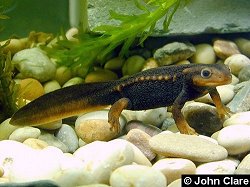
|
|
||||||||||
| Juvenile male T. verrucosus | |||||||||||
Description
In 1995, Nussbaum et al. published "A taxonomic review of Tylototriton
verrucosus". Until 1995, most if not all authorities considered
Tylototriton verrucosus and T. shanjing to be the same species. Comparing individuals of these species, the differences become quite apparent, and one may well wonder why the two were not considered separate species from the outset. A photo of a bright orange newt with the caption "Tylototriton
verrucosus" is a common sight in books and literature. This situation is complicated by the fact that the species known as
Tylototriton verrucosus occupies a large range (see below), and animals from different parts of the range may exhibit distinct morphological and behavioural differences, including large differences in adult size, colouration and body/appendage shape.
These differences have led me to conclude that T. verrucosus is quite probably
a complex of several subspecies or perhaps even full species. However, until
phylogenetic and morphological studies are carried out on animals from known localities across the range, this group will remain one species.
In my experience, there are at least two, possibly three commonly available variants within this species.
For the present work these variants are:
1. T. shanjing-like" variant: This variant exhibits similarities in colouration and morphology to those of T. shanjing. The head is similarly shaped to that of T. shanjing, being less triangular and narrower than that of variants 2 and 3 described below. Maximum adult size: ~17 cm (~7 inches).
2. "Light" variant: The largest variant, possessing a relatively slim profile, relatively narrow tail and head with faded/lighter brown colouration than variant 3. The head is wider than that of T. shanjing and it possesses some traits of variant 1 and some of variant 2. Maximum adult size: ~24 cm.
3. "Dark" variant: The least similar of the three variants to T. shanjing, possessing more rounded body features such as a wider head and body (less noticeable when comparing males), higher tail fin and dark brown to black base colouration. It has been my experience that the dark variant is more hydrophilic (i.e. the dark variant seems to like aquatic conditions more than the light variant). This variant possesses the most angular head of the three variants. Maximum adult size: ~17 cm but generally a little smaller.
Unfortunately locality data for the three variants is not known with certainty due to the acquisition of animals through the pet trade and the frequent "inaccurate" reporting of locality data by exporters. The three proposed variants are pictured below. Variants 1 and 2 appear to be quite similar but the head shape appears to be distinct and there is a large contrast between the adult body lengths of each.
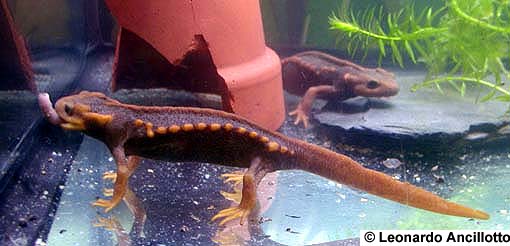
"T. shanjing-like" variant |

"Light" variant |
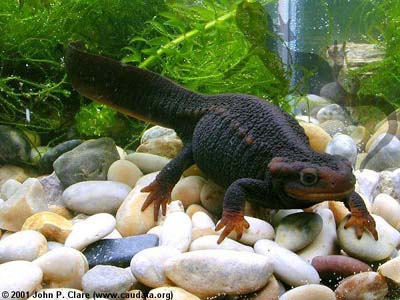
"Dark" variant |
All variants of the Himalayan Crocodile Newt are large and robust newts. The base colouration is chocolate brown-to-black, with areas of orange or brown on the tail, head, legs and tubercles of the rib peaks. The degree of orange varies between individuals and between variants, and adults tend to be darker than juveniles. The head is flattened when viewed from above (less so in variants 1 and 2) and angular (in variants 1 and 2 this is less apparent and T. shanjing possesses a relatively straight head). The sides of the head have bony and glandular areas elevated to the level of the upper eyelids (Kuzmin). There are tubercles on the rib peaks, as in T. shanjing, but unlike T. shanjing the dorsal ridge of T. verrucosus variant 3 tends not to be bright orange. In variants 1 and 2 this ridge is generally a noticeably lighter brown than the base colouration or even slightly orange. When aquatic, the skin texture becomes less granular and the base colouration darkens, leading to more contrast with the lightly coloured or orange highlights.
The Himalayan Crocodile Newt is the most aquatic of the four species of crocodile newt (Tylototriton) that are likely to be encountered in captivity, the others being T. shanjing, T. kweichowensis and T. taliangensis. Depending on temperature, during the spring, summer and autumn months these newts will often remain completely aquatic and will rarely, if ever, emerge from the water. This is a very active and inquisitive newt when aquatic, and it can become reasonably tame in captivity, going so far as to swim actively at the glass for food and taking food from forceps and fingers.
These newts can live in excess of 10 years and probably a lot longer.
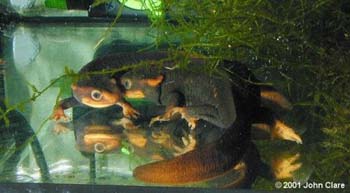 T. verrucosus pair in mating dance. |
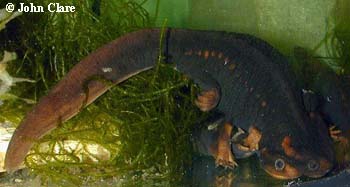 T. verrucosus pair in amplexus. |
Natural Range and Habitat
Tylototriton verrucosus has been recorded from
Yunnan Province in China (Zhao and others), northern
Thailand, northern Vietnam, northern Burma, northeastern
India, Bhotan and eastern Nepal. It is debatable whether
some of these records are of Tylototriton verrucosus
and not T. shanjing. Its range seems to follow
areas of reasonable elevation (foothills of mountains,
etc) and it is said to occur in various habitats where
mountain forests exist or previously existed, such as
cultivated rice fields (Kuzmin and others). It is said to
be unfussy when it comes to breeding pools, using
anything from puddles to lakes.
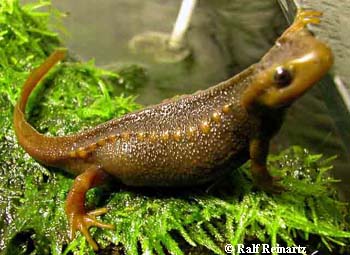 T. verrucosus are often very tame. |
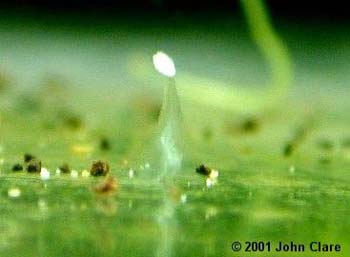 Spermatophore. |
Housing
These observations are primarily based on my experience with variant 3 and to a lesser extend on my experience with variant 2.
Above about 18°C (64°F), the Himalayan Crocodile Newt can be maintained in completely aquatic conditions. An aquarium measuring 60 cm long x 30 cm deep x 37 cm tall (24
x 12 x 15 inches) is adequate for 2 adult pairs of variant 3, fewer in the case of the variant 2.
Water depth is not important, but 12-15 cm (5-6 inches) is a good level. If maintained in an aquatic setup, a sizable island should be provided for the animals to emerge from the water should they choose to do so.
An animal that spends most of its time out of the water (some young animals behave like this, particularly those of variant 2 and probably variant 1 as well) should be moved to a semi-aquatic setup.
In my experience, a good temperature range for these animals is 15-18°C (59-64°F) in winter with a rise in summer to about 25°C (77°F). Variant 3 can tolerate much higher (for periods of several days) and lower temperatures than these without ill effects. Filtration, if required, can be accomplished in any of the usual ways, and these newts are reasonably tolerant of flowing water, though as a general rule with pond-type newts this should be kept to a minimum. Like most newts, this species does well in a planted tank. A photoperiod of about 12 hours a day in summer is a nice touch, though not essential. Remember to ensure water quality is maintained by making regular water changes - 20-30% or so every two weeks is usually adequate unless there is a lot of waste food and detritus. Remember to treat tap water with a water conditioner prior to use as it may contain harmful substances (chlorine, chloramines and metals).
If you choose a semi-aquatic setup, such as a 50% land:50% water arrangement, be sure the animals can emerge from the water without difficulty.
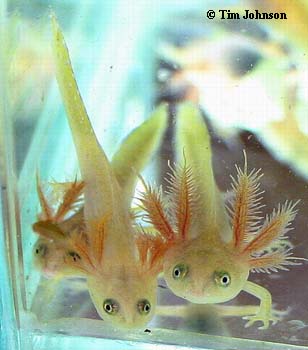 Larvae. |
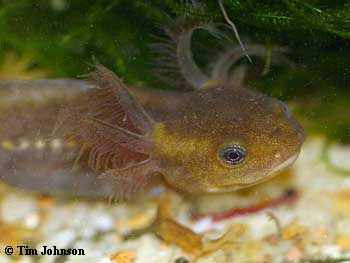 Larva. |
Feeding
These newts are not reluctant feeders, and large females can consume an astonishing amount of food in a short time. They will eat earthworms (whole small-to-medium worms or chopped large worms), tubifex worms (live, frozen, or freeze-dried - some times incorrectly labelled as "bloodworms"), bloodworms (the larvae of
Chironomus midges), blackworms (an aquatic relative of earthworms), crustaceans like shrimp, pieces of fish (avoid salted fish and marine fish), strips of beef heart or other lean red meat, etc. Like most newts, when aquatic they have a very keen sense of smell and they can find uneaten food, even at night in total darkness.
As with most newts and salamanders, the warmer they are kept, the more regularly they should be fed.
As much food as they will eat in 15 minutes is a good guide. They can be fed twice a week in summer, but I personally feed mine once every two days and less frequently in winter.
If you feed a large amount of food at each sitting and then a few days later you observe your animals spending large periods of time on their island during warm periods, it is a good indication of high ammonia or nitrite levels present in the water from uneaten food, and one would be wise to feed more regularly with small amounts.
One final important note regarding feeding. Females tend to be more aggressive than males, and in a tank containing mixed sexes, the males frequently get less food than females if left to fend for themselves. It is important to monitor males to be sure they are eating well. Females tend to have a much higher capacity for food than males, so don't judge a male's eating habits by comparing its bulk to a female.
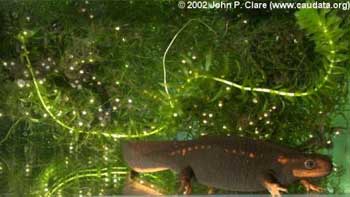 Female with eggs. |
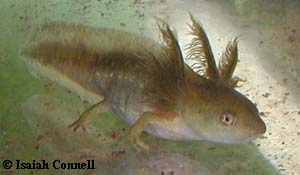 Larva. |
Breeding
The following mating and courtship information is based on the author's experience with variant 3.
Size at maturity and courtship behaviour may vary for the other variants. These newts can reach sexual maturity in just a year, usually at a minimum length of
13 cm (5 in) in males and slightly larger in females. Males tend to be more brightly coloured than females, though this isn't a strict rule.
The fin of the male may deepen during the warmer months of the year and the animal is aquatic.
The cloaca of the sexually mature aquatic male is noticeably swollen when compared to that of the female. Animals not in breeding condition can be sexed by comparing the length of the cloacal opening - in males this is slightly longer than in females - and on average the male's tail fin height is greater than that of the female.
One strange difference between the sexes of variant 3 is that the eyes of the sexually active male appear to be surrounded by a pale line which is not as highlighted in the female. The key to stimulating breeding in these newts seems to be a temperature change. In my experience, a temperature increase from 18°C (64°F) to 22-25°C (72-77°F) over a few hours or even a few days usually leads to breeding activity as will a large water change. This alone seems to be adequate, but photoperiod probably also plays a role.
Males tail-fan females in the same manner as Triturus newts, but at a slower rate.
I have observed that the male will clasp the female in a Pleurodeles-like
embrace on several occasions. Some sources describe spermatophore exchange taking place with the male using this embrace to guide the female onto a spermatophore, as is the case in
Pleurodeles. However I have observed spermatophore transfer take place many times during a circular courtship dance, similar to that employed by
T. shanjing. The male deposits a number of spermatophores as he moves in the circle and the female picks up one or more in her cloaca.
I have never observed spermatophore transfer via an embrace. In my
experience males will only embrace females in the presence of other males, i.e.
it is a method of monopolising a female. The male will frequently swim
with the female in his grasp to an area of the tank that is free of other
animals, and then a circular courtship will commence. Mating usually takes place at night. When the tank is allowed to undergo a yearly cycle of temperature change mating should occur naturally without any interference from the keeper.
Oviposition generally begins within 36 hours of mating, though sometimes it may take longer. In captivity, females can lay anything from 30 eggs to over 150 or more in one spawning, depending on the size and bulk of the female in question. The author once counted in excess of 300 eggs laid by one female in one spawning which led to over 280 larvae hatching (this was verified by taking a photograph of the bare tank and counting the larvae by hand). The eggs are relatively small for the genus at about 5 mm in diameter, including jelly. At 25°C (77°F) the eggs hatch in 10-12 days and are faster developing than many other species (e.g. Cynops ensicauda). Newly hatched larvae are about 8-9 mm long and only begin feeding a few days after hatching during which time they utilise the remainder of the yolk in their digestive tract (visible as a cream-coloured substance in the belly). The larvae do well at temperatures between 20 and 27°C (68-81°F), which is quite warm compared to most species. The initial few days can be a delicate time, but foods such as newly-hatched brine shrimp, young Daphnia and microworms are ideal first foods. Once the larvae reach 12 mm or so, young Daphnia can make up the bulk of their diet. When they reach 20-25 mm, they can begin feeding on foods such as frozen bloodworms and live blackworms (preferably minced/chopped as much as possible), in combination with adult Daphnia. Metamorphosis is reached at between 5 and 7 cm, though sometimes larvae will metamorphose at smaller or much larger sizes. Paedomorphic individuals occur in most clutches, and these sometimes don't finish metamorphosis until after sexual maturity is attained at 12 cm or more (Sparreboom; Wallays). They are quite capable of breeding in this state (Sparreboom). Unusual for most newts, after metamorphosis, Himalayan Crocodile Newts usually don't require a terrestrial phase, though a semi-aquatic setup is probably best until the animals are at least 10 cm (4 inches) long.
A series of photographs showing the early development of this species is available on this site at Tylototriton verrucosus Developmental Photo Series.
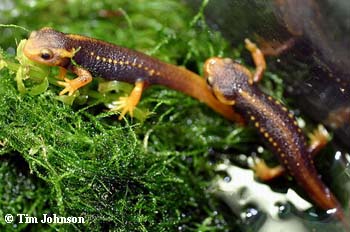 Juveniles, "light form". |
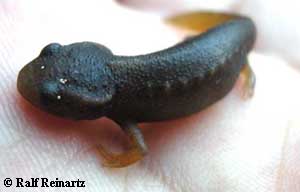 Juvenile, "dark form". |
References
Duellman, William E. and Trueb, Linda (1994). Biology
of Amphibians. Johns Hopkins University Press.
Fleck, J. (1996). Neues über die Gattung Tylototriton [News about the Genus Tylototriton] elaphe 4(2): 79-80.
Fleck, J. (1999). Weitere Beobachtungen an den Gattungen Echinotriton/Tylototriton [Further observations of the genera Echinotriton/Tylototriton] elaphe 7(2): 66-67.
Kuzmin, Sergius L. AmphibiaWeb Data Sheet (https://amphibiaweb.org/species/4309).
Nussbaum, R. A., Brodie Jr., E. D., Datong Y. (1995). A taxonomic review of Tylototriton verrucosus Anderson (Amphibia: Caudata: Salamandridae). Herpetologica 51(3): 257-268.
Rehberg, F. (1986) Haltung und Zucht des Krokodilmolches Tylototriton verrucosus [Husbandry and Breeding of Tylototriton verrucosus] Anderson, 1871. Herpetofauna, Weinstadt 8(45): 11-17.
Sparreboom, M. (1999). Haltung und Nachzucht von Tylototriton verrucosus [Husbandry and Breeding of Tylototriton verrucosus] elaphe 7(2): 20-24.
Wallays, Henk (1999/2000/2001). Personal communication.
Zhao, E. and Adler, K. (1993). Herpetology of China. SSAR, Oxford (Ohio).
Additional Resources
CC Field Observations in Chiang Mai, Thailand, of Tylototriton verrucosus, the Himalayan Crocodile Newt
© 2001 John P. Clare. Updated February 2004 by John P. Clare.
